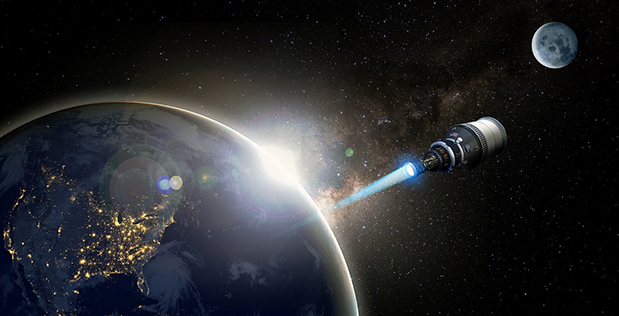As the space race intensifies, the United States is gearing up to send a nuclear rocket to space to explore and monitor the areas of strategic importance.
F-18 Super Hornets – Did Tom Cruise Really Fly US Navy’s Powerful Fighter Jet in “Top Gun: Maverick”?
The US military is seriously preparing to proceed with the development of a nuclear rocket to aid in the monitoring of Earth-moon space or cislunar space, which it has designated as a high strategic priority.
The US Department of Defense’s research and development arm, the Defense Advanced Research Projects Agency (DARPA), announced on May 4 that it is seeking proposals for the second and third phases of a project to design, manufacture, and construct a nuclear thermal rocket engine for a flying demonstration in Earth orbit by 2026.
The idea has been in the works for a while, and the first phase of the project, Demonstration Rocket for Agile Cislunar Operations (DRACO), was started by the US in 2021.
“These propulsive capabilities will enable the United States to enhance its interests in space and to expand possibilities for NASA’s long-duration human spaceflight missions,” DARPA officials said in a statement.
Pak-Origin Entrepreneur Responds To #BuyMeAFighterJet Call From Ukraine; Buys 2 Warplanes For Kiev — Report
The nuclear propulsion technology would allow the craft to go further using less propellant than chemical rocket systems currently in use.

According to DARPA, the Demonstration Rocket for Agile Cislunar Operations (DRACO) would also allow for agile spacecraft maneuvers in orbit, which is a goal for future space operations. In the event of a conflict in space, the quick movement would be critical to avoid opposing craft.
In 2026, DARPA wants to conduct a flight demonstration of nuclear thermal propulsion (NTP) that will send a spacecraft into Earth’s orbit. The engine could eventually be used to travel across cislunar space, the space between Earth and the moon. (The moon is 238,855 miles away from us on average.)

According to the Office of Nuclear Energy, the same technology may transport humans on long-duration spaceflight missions. Going to Mars, for example, could be one of them.
DRACO is part of a bigger effort by the US military to keep an eye on cislunar (Earth-moon) space as government and private activity in this sector is set to grow in the future decade, especially with China sending several missions to space and enhancing its presence to challenge the US hegemony in space.
China is also set to develop a lunar base before the end of this decade, together with Russia.
Nuclear Rockets To Take Off Soon?
Nuclear Thermal Propulsion (NTP) systems that the US is seeking for its spacecraft under the DRACO project work using fission reactors. To generate thrust, the reactors heat hydrogen or other propellants to extremely high temperatures and then eject the superheated gas through nozzles.
NTPs have a thrust-to-weight ratio 10,000 times higher than electric propulsion systems. According to DARPA officials, in comparison to typical chemical rockets, the propulsion efficiency (or specific impulse) of NTPs is around two to five times higher.
The DRACO program began with a conceptual design for a rocket engine reactor from General Atomics. Two other spaceflight companies, Blue Origin and Lockheed Martin, presented two conceptual spaceship designs to the program in 2021.
Nuclear thermal propulsion rockets can reduce travel times to Mars by up to 25% and, more importantly, limit a flight crewʼs exposure to cosmic radiation?⚛. Learn more: https://t.co/gLFyd41C5p pic.twitter.com/EHhAXplb2t
— U.S. Department of Energy (@ENERGY) February 15, 2021
DRACO Phase 1 comprised awards to General Atomics, Blue Origin, and Lockheed Martin in April 2021. The phase was supposed to span 18 months and would be split into two parts.
Track A for General Atomics included the basic design of a nuclear thermal propulsion reactor, as well as a propulsion subsystem.
Blue Origin and Lockheed Martin pursued Track B separately to develop an “operational system spacecraft concept” to meet future mission objectives, including a demonstration system.
DARPA also awarded Gryphon Technologies, a Washington-based company that provides engineering and technical solutions to national security organizations, a $14 million task order for DRACO.
DARPA has awarded a $22 MM contract to General Atomics for the "Demonstration Rocket for Agile Cislunar Operations" Track A effort. DRACO will demonstrate a nuclear thermal propulsion system on orbit. Track A funds the baseline design of a NTP reactor. https://t.co/PQwM4ZTJCT pic.twitter.com/AEdJijxrLu
— Air Power (@MIL_STD) April 9, 2021
Now, DARPA is holding an open competition to ensure that the project isn’t limited to the companies that are currently committed.
The defense agency wants detailed proposals that show how engineers will design, develop, produce, and assemble the engine. The deadline for submissions is August 5.
Since the 1960s, scientists have been researching nuclear thermal propulsion. Los Alamos National Laboratory scientists assisted in the development and testing of nuclear rockets when the Nuclear Engine for Rocket Vehicle Application program was operational, according to Popular Mechanics.
How to be in two places at once: Mars explorers are using the @NASAPersevere rover and the Ingenuity #MarsHelicopter to scout more terrain than would be possible with just one vehicle – https://t.co/8NWjqo95dX pic.twitter.com/mM4KlBMD5j
— NASA Mars (@NASAMars) May 4, 2022
NASA is especially interested in nuclear thermal propulsion because it has the potential to get expeditions to Mars in half the time that existing propulsion technologies can take.
NASA’s budget request for the fiscal year 2023, which is yet to be approved by Congress, contains $15 million to support nuclear propulsion.
Given the need to dominate space and the efficiency of nuclear propellant, the US could soon be sending its nuclear rockets to space and revolutionizing its maneuvers as the space race and its gradual militarization continues in full earnest.
- Contact the author at sakshi.tiwari9555@gmail.com
- Follow EurAsian Times on Google News





